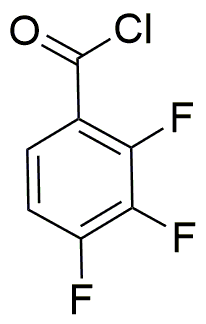2,3,4-Trifluorobenzoyl chloride is widely utilized in research focused on:
- Synthesis of Fluorinated Compounds: This chemical serves as a key reagent in the synthesis of various fluorinated organic compounds, which are important in pharmaceuticals and agrochemicals.
- Pharmaceutical Development: It is used in the development of new drugs, particularly those that require fluorinated moieties for enhanced biological activity and stability.
- Polymer Chemistry: The compound is employed in the modification of polymers to improve their properties, such as chemical resistance and thermal stability, making it valuable in materials science.
- Analytical Chemistry: It acts as a derivatizing agent in analytical methods, aiding in the detection and quantification of various analytes in complex mixtures.
- Research in Agrochemicals: The chemical is also significant in the formulation of agrochemicals, where fluorination can enhance the efficacy and environmental stability of pesticides.
General Information
Properties
Safety and Regulations
Applications
2,3,4-Trifluorobenzoyl chloride is widely utilized in research focused on:
- Synthesis of Fluorinated Compounds: This chemical serves as a key reagent in the synthesis of various fluorinated organic compounds, which are important in pharmaceuticals and agrochemicals.
- Pharmaceutical Development: It is used in the development of new drugs, particularly those that require fluorinated moieties for enhanced biological activity and stability.
- Polymer Chemistry: The compound is employed in the modification of polymers to improve their properties, such as chemical resistance and thermal stability, making it valuable in materials science.
- Analytical Chemistry: It acts as a derivatizing agent in analytical methods, aiding in the detection and quantification of various analytes in complex mixtures.
- Research in Agrochemicals: The chemical is also significant in the formulation of agrochemicals, where fluorination can enhance the efficacy and environmental stability of pesticides.
Documents
Safety Data Sheets (SDS)
The SDS provides comprehensive safety information on handling, storage, and disposal of the product.
Product Specification (PS)
The PS provides a comprehensive breakdown of the product’s properties, including chemical composition, physical state, purity, and storage requirements. It also details acceptable quality ranges and the product's intended applications.
Certificates of Analysis (COA)
Search for Certificates of Analysis (COA) by entering the products Lot Number. Lot and Batch Numbers can be found on a product’s label following the words ‘Lot’ or ‘Batch’.
*Catalog Number
*Lot Number
Certificates Of Origin (COO)
This COO confirms the country where the product was manufactured, and also details the materials and components used in it and whether it is derived from natural, synthetic, or other specific sources. This certificate may be required for customs, trade, and regulatory compliance.
*Catalog Number
*Lot Number
Safety Data Sheets (SDS)
The SDS provides comprehensive safety information on handling, storage, and disposal of the product.
DownloadProduct Specification (PS)
The PS provides a comprehensive breakdown of the product’s properties, including chemical composition, physical state, purity, and storage requirements. It also details acceptable quality ranges and the product's intended applications.
DownloadCertificates of Analysis (COA)
Search for Certificates of Analysis (COA) by entering the products Lot Number. Lot and Batch Numbers can be found on a product’s label following the words ‘Lot’ or ‘Batch’.
*Catalog Number
*Lot Number
Certificates Of Origin (COO)
This COO confirms the country where the product was manufactured, and also details the materials and components used in it and whether it is derived from natural, synthetic, or other specific sources. This certificate may be required for customs, trade, and regulatory compliance.


